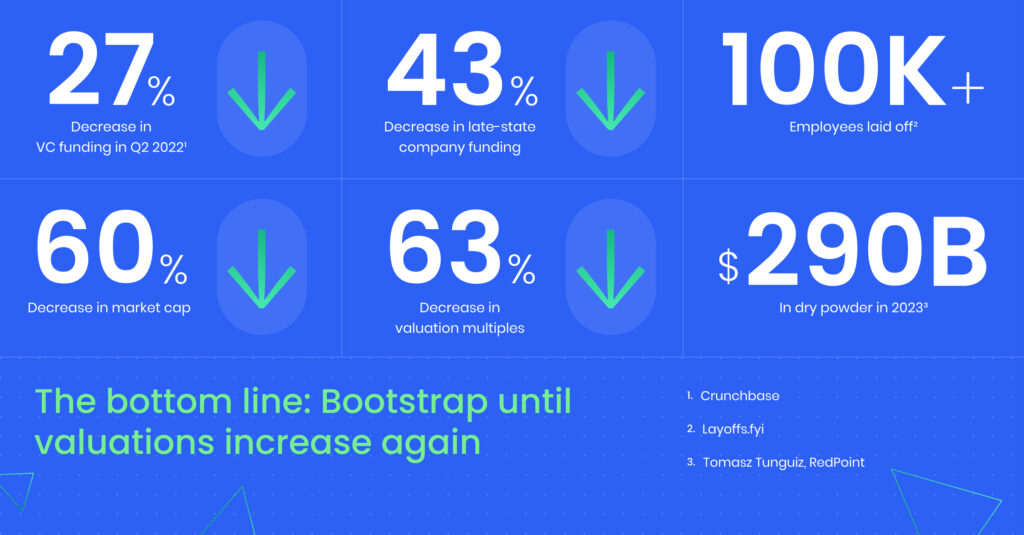Why Now is the Time for Startups to Embrace the Freedom of Bootstrapping
Published on

Warning bells have been sounding across the tech industry for the past six months as the cash crunch tightens its noose on VC funding. Now is the time for all startups to practice bootstrapping.
The heady days of free-flowing VC funding are over, at least for now.
Since May, prominent VC firms have been warning portfolio companies to shore up cash and cut costs to extend their runway because very little funding is coming from venture capitalists in the near term.
Startup accelerator Y Combinator warned its portfolio companies that venture capital would slow down due to increasing interest rates and a global economic slowdown; Sequoia Capital warned that rising inflation and continued geopolitical tension would mean a longer road to recovery; Redpoint Ventures’ Tomasz Tunguz said start-up investors have been advising their companies to keep enough cash for at least two years of potential pain.
Data proves these warnings are warranted:
- VC funding in Q2 2022 fell 27% from Q1.
- Late-stage company funding contracted by 43% in Q2.
- Over 100,000 tech employees were laid off in 2022 so far, according to industry tracker Layoffs.
This turn of events is particularly jarring to first-time entrepreneurs who have never operated in an industry where funding was hard to come by. Those that succeed will rise to the challenge of operating—and even growing—their startups with little equity-based investment.
Bootstrapping is Going Mainstream
Bootstrapping is a great alternative when VC funding is unavailable. It also instills discipline around capital efficiency that can get lost in the “free money” mentality connected with VC funding.
Bootstrapping can teach startups to think like camels, not unicorns: Camels can survive for long periods without food or water and adapt to extremely harsh climate conditions. Similarly, founders who can adapt to the current economic climate and survive long periods without VC funding will come out stronger on the other side of this recession.
On the other hand, startups that are burning cash—betting it all in the search for unicorn status—will struggle to find investors. Albert Wenger and fintech entrepreneur Tim Duncan summed up the psychology of investors on Twitter recently:
IMHO the most important dynamic is that exit options disappear for all but the most stellar startups. As the possibility that new investors/buyers will see value in the losers dwindles, the original investors just deal with reality and don’t throw good money after bad.
— Tim Duncan (@NotThatTimD) October 26, 2022
Finding Cash as a Bootstrapper
Being bootstrapped does not mean a startup is entirely funded by personal cash investments from the founding team. A bootstrapped company finds non-dilutive forms of cash in several ways:
1. Customer cash
Acquire as many customers as you can while meticulously monitoring your key performance indicators. The hands-down best way to access startup capital is from your own customers. You can ask customers to pay upfront to access more working capital to fund your growth. Plus, customer retention is a great way to prove you are maintaining product-market fit if you do decide to negotiate with investors down the line.
2. Government startup financing
Wherever you’re based, it’s likely that your government offers support for startups and small businesses. In Canada, you can apply for various grants, loans, and subsidies at both provincial and federal government levels. In the United States, you can explore loan options from the Small Business Administration (SBA), GovLoans, and the Small Business Lending Fund (SBLF) and grants are available from local- and state-level organizations.
The challenge with these programs is that the application process requires a lot of effort. Your applications, business plans, and reporting need to be pristine. However, the outcome is worth it—you get cheap (or free) capital to fuel your business so get good at paperwork or hire an expert to help you with it!
3. Bank loan or line of credit
Depending on your past history, banks may lend you a small amount of money to keep your business going. Interest rates may be higher, but as valuations continue to dip, debt will be a much cheaper option in the medium to long term than venture capital.
There are many things to consider before applying for a loan, but be sure of what you want and have your personal finances in order. It’s important to be wary of requirements to post collateral or secure loans on personal assets (i.e. your home).
4. Alternative lenders like TIMIA
There are some excellent alternative lending options available to startups with recurring revenue. However, beware of some lenders promising short-term loans like MRR to ARR loans, as these can have amortized interest rates of up to 52% and can be detrimental to cash flow.
TIMIA doesn’t take any equity in the business and our loans are interest-only, so you don’t get bogged down with high repayments that take working capital from the business. Take a look at our offerings and browse our customer stories to see if we would be a good fit for your growth stage.
Interest rates may be rising, but as valuations continue to slide, debt will remain a much lower cost than venture capital in the medium to long term.
Cash Flow Positivity is Crucial
Startups need to keep a close eye on cash flow dynamics. The team over at SaaS Capital wrote an excellent post on this topic a couple of years ago. If your company is collecting annual revenue commitments upfront on new customers, you could be consuming deferred revenue and generating no cash from it due to the economic slowdown. Therefore, renewals and new bookings sources of cash are not keeping up with churn and revenue recognition. Cash flow will decline much quicker than the P&L indicates.
On the positive side, recessions are cyclical. Tomasz Tunguz shared a perspective on this at a recent conference. He said we’ve gone back to 2017/2018 valuation multiples—that’s not too bad! Cash flow is king for the next 18-24 months as we wait out this recession. If startups can conserve cash, use alternative growth capital, and extend their runway, they’ll be in a great position in the second half of 2023.
There is $290B in dry powder that will be released by venture capitalists when things start to turn around. Bootstrappers with good capital efficiency will be ready to take advantage of it.

Shore Up Cash to Secure Runway
In a recent webinar, Mark Godley from LeadGenius, a TIMIA portfolio company, shared some advice with his fellow startup CEOs facing the latest economic landscape, “Cash is king—[secure it] sooner than you think you need it, and more than you think you need.”
To do this, check out a post by our CEO, Mike Walkinshaw, who shared some tips on how businesses can overreact to the current economic landscape—and ensure the longevity of their business.
Back to top



